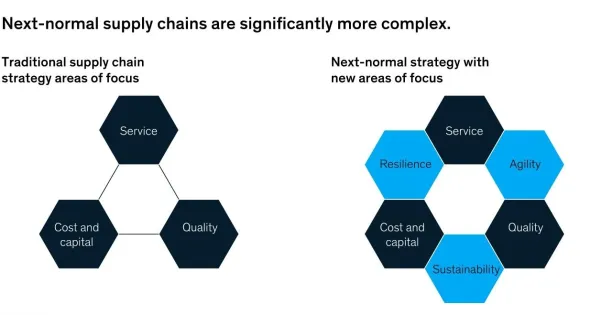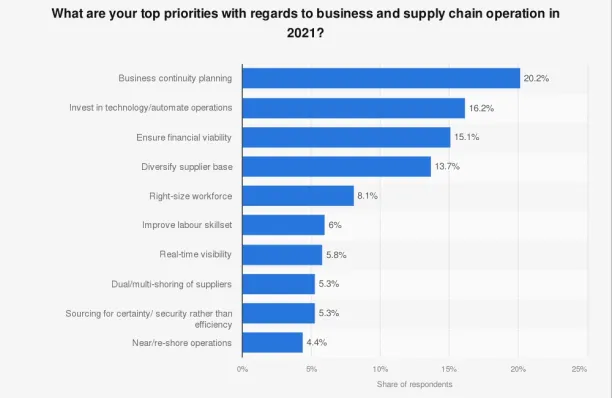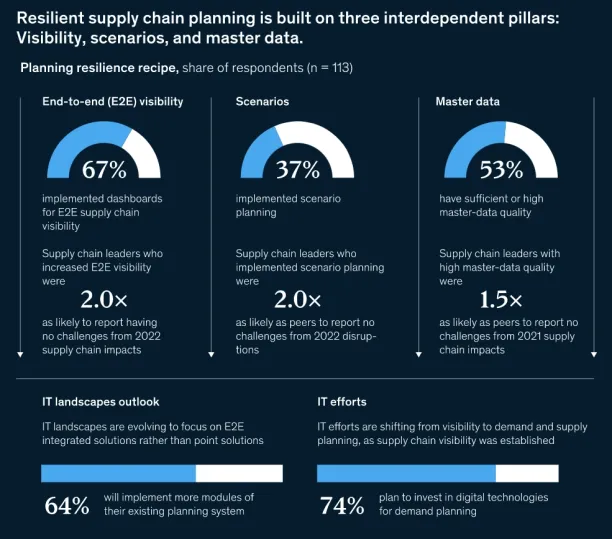Supply Chain Visibility Software Comparison in 2024
Studies (Figure 1) show that modern supply chains are more complex than traditional ones and require a different management approach.
Figure 1. Studies show that modern supply chains require a different approach.

Having a holistic view of your supply chain is crucial for achieving resilience, agility, and sustainability, which is why it has become one of the top priorities of supply chain leaders Figure 2.
Figure 2. Top priorities of executives according to a survey

By leveraging sophisticated supply chain visibility software, companies can overcome challenges, streamline operations, and ultimately drive success.
To help supply chain leaders obtain a clear view of their value chain, this article covers:
- The importance of supply chain visibility,
- How modern software can help
- 6 factors to consider when choosing the right vendor
- A comparison of the top supply chain visibility solutions on the market.
What is supply chain visibility?
Supply chain visibility is the ability to track and monitor every aspect of your supply chain in real-time, from raw materials to finished products. This level of oversight allows businesses to identify potential issues, optimize processes, and make informed decisions. In an increasingly globalized market, having a clear understanding of your supply chain is more important than ever.
Click here to learn more about how to improve your supply chain’s visibility.
How can modern software help overcome supply chain visibility challenges?
Supply chain visibility tools offer a range of features that help businesses overcome common challenges, such as:
- Limited access to information
- Siloed data
- Manual processes
By centralizing and analyzing data, these solutions provide actionable insights that enable organizations to improve efficiency, reduce costs, and enhance customer satisfaction. Here’s how advanced supply chain visibility software can transform your operations:
- Real-time tracking: Monitor every aspect of your supply chain, from inventory levels to shipment status, and make informed decisions on the fly.
- Advanced analytics: Identify trends, uncover hidden opportunities, and forecast future demand using sophisticated algorithms and machine learning.
- Collaboration tools: Streamline communication and coordination among suppliers, manufacturers, and logistics providers.
Studies show that companies using software that offer dashboards for end-to-end supply chain visibility were twice as likely to overcome supply chain challenges in 2022 (Figure 3). The study also shows that about 74% of respondents have established supply chain visibility technologies and are focusing digital efforts on demand planning.
Figure 3. Supply chain visibility dashboards help achieve supply chain resilience.

Factors while shopping for supply chain visibility platforms
To maximize the benefits of supply chain visibility software, it’s essential to choose a solution tailored to your business’s unique needs. Here are the top five factors to consider:
1. Customization & User-friendliness
Customization and ease of use are important factors when selecting a supply chain visibility software. A solution that is intuitive and easy to navigate, for example, will enable a more seamless transition and reduce the time required for your team to become familiar with it.
You can consider no-code or low-code solutions based on your needs and level of digital dexterity.
Example
For instance, a retailer might not have a team with coding capabilities and still requires a high level of customization to integrate its system with its suppliers’. In this case, it can benefit from a no-code platform.
2. Integration with Supply Chain Management (SCM) platforms
The effectiveness of your supply chain visibility software relies heavily on its ability to integrate with your existing supply chain management (SCM) platforms. Seamless integration enables the software to access and analyze data from multiple sources, providing a comprehensive view of your supply chain. Look for solutions that offer pre-built integrations with popular SCM platforms or custom integration options such as low or no-code capabilities.
Example
Suppose a clothing manufacturer uses an ERP system to manage its procurement and production processes. To ensure a smooth transition, they should choose a supply chain visibility software that integrates with their existing ERP system.
3. Number of employees of the vendor
Bigger is not always better. Some studies1 suggest that small, medium-sized businesses or SMBs can offer a more personal and customized service since they prioritize customer service.
Therefore, make sure the vendor has a trustable minimum company size (ideally 25+ employees) and test their customer service capabilities before making any commitments.
4. Type of solution offered
There are various types of supply chain visibility software, each offering different features and capabilities. Some solutions focus on specific aspects of the supply chain, such as inventory management, while others provide end-to-end visibility across all processes. Consider the specific pain points and objectives of your organization when evaluating vendors.
Example
A global manufacturer wants to optimize its inventory levels and reduce carrying costs. It should prioritize solutions that offer robust inventory management features, such as demand forecasting and automated replenishment.
5. Industry-specific requirements
Different industries have unique supply chain challenges and requirements. For instance, the pharmaceutical industry must adhere to strict regulations regarding product traceability, while the automotive industry requires seamless coordination among numerous suppliers and manufacturers. Choose a platform that understands the intricacies of your industry and offers tailored solutions to address its specific needs.
Example
Consider that a pharmaceutical manufacturer needs a solution that helps them comply with regulations, such as the Drug Supply Chain Security Act (DSCSA). It should prioritize software that offers features like serial number tracking and electronic pedigree documentation.
6. Customer support and training
Implementing a new supply chain visibility software can be a complex process that requires thorough training and ongoing support. Evaluate the quality of customer service offered by the software provider, including their responsiveness, expertise, and availability. Additionally, consider the training resources available, such as webinars, tutorials, and dedicated account managers, to ensure a smooth onboarding process for your team.
Example
A logistics service provider or LSP wants to train its staff on a new AI-powered real-time shipment tracking system. It should choose a provider that offers comprehensive training materials and responsive customer support to help the team quickly adapt to the new solution.
Comparison of the top supply chain visibility software vendors on the market
Chosen criteria
The criteria selected for this comparison include customization based on low/no-code capabilities, integration to SCM platforms, and number of employees. These criteria were selected based on data availability.
The other 3 criteria (Type of solution offered, industry-specific requirements, & customer support and training) need to be evaluated by the users as they contact the vendors. Since these 3 criteria are specific to business needs, they can differ from company to company.
Table 1. Vendor comparison
| Vendors | Customization | Integrations to SCM platforms*, ** | # of employees on Linkedin as of April 2023 |
|---|---|---|---|
| Pegasystems | Low code | – SAP – Oracle – Microsoft SQL server – PostgreSQL | 5,803 |
| Appian | Low code | – SAP – Oracle | 2,271 |
| OutSystems | Low code | – SAP – MongoDB – PostgreSQL | 1,960 |
| Mendix | Low code | – SAP – Siemens Teamcenter | 1,284 |
| UCBOS | No code | – SAP – Oracle SCM – Mercury Gate TMS –
Manhattan – Blueyonder – Coupa
| 53 |
| Regrello | No code | – Oracle – SAP | 38 |
Notes (Table 1):
- Based on vendor claims: *
- Not comprehensive: **
- The vendors compared in this table were selected based on the relevance of their offerings and having 25+ employees.
Conclusion
Selecting the ideal supply chain visibility solution is a critical step in optimizing your business’s supply chain operations. By considering the factors outlined in this article and the vendor comparison table, you can make an informed decision that sets your organization on the path to success.
Further reading
If you need help finding a vendor or have any questions, feel free to contact us:
References
- Mitto (Nov 16, 2022). Omnichannel Messaging is Critical for a Positive Customer Experience, says two-thirds of SMBs. Accessed: 05/May/2023



Comments
Your email address will not be published. All fields are required.